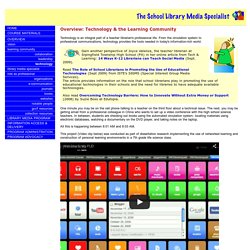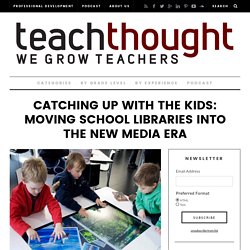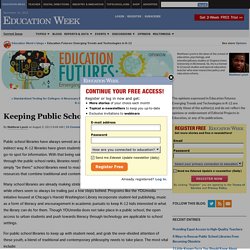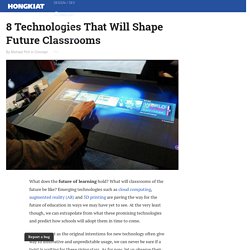

The School Library Media Specialist: Overview. Technology is an integral part of a teacher librarian's professional life.

From the circulation system to professional communications, technology provides the tools needed in today's information-rich world. Gain another perspective of Joyce Valenza, the teacher librarian at Srpingfield Township High School (PA) in her online article from Tech & Learning: 14 Ways K-12 Librarians can Teach Social Media (Sept. 2009). Read The Role of School Librarians in Promoting the Use of Educational Technologies (Sept 2009) from ISTE's SIGMS (Special Interest Group Media Services).
The article provides information on the role that school librarians play in promoting the use of educational technologies in their schools and the need for libraries to have adequate available technologies. Also read Overcoming Technology Barriers: How to Innovate Without Extra Money or Support (2008) by Suzie Boss at Edutopia. All this is happening between 8:01 AM and 8:03 AM. Read S. Catching Up With The Kids: Moving School Libraries Into The New Media Era - Catching Up With The Kids: Moving School Libraries Into The New Media Era Libraries have done a world of good for schools.

They provide a self-directed learning environment and a quiet place to work and study — not to mention the wealth of carefully organized stories, articles, reference materials and other information for students to use whenever they need it. It’s no secret that the library is essentially a campus warehouse for media products. Trouble is, media is changing. Sir Kenneth Robinson, a writer and speaker on issues and opportunities in education, makes a good point: Technology isn’t technology if it already existed when you were born.
School Library 2.0 Even just in terms of available information, the library of today is a very different place from the library of 50 years ago. In our case, not only could the material that students are reading use an update, but the material they’re reading it on is becoming outdated. Keeping Public School Libraries Relevant - Education Futures: Emerging Trends and Technologies in K-12. Public school libraries have always served an admirable purpose in education.

In an indirect way, K-12 libraries have given students support in learning endeavors and been a go-to spot for information. With that being said, as the first Internet-generation rises through the public school ranks, libraries need big changes to remain relevant. It is not enough to simply "be there;" school libraries need to reach out to students and pull them in with helpful resources that combine traditional and contemporary theories in literacy.
Many school libraries are already making strides to capture and maintain the interest of students, while others seem to always be trailing just a few steps behind. Programs like the YOUmedia initiative housed at Chicago's Harold Washington Library incorporate student-led publishing, music as a form of literacy and encouragement in academic pursuits to keep K-12 kids interested in what the library can do for them. School libraries shelve tradition to create new learning spaces. What happens to school libraries when students find it more natural to turn to a computer screen than a book?

That is the question facing schools around the world as they struggle to keep up with the digital revolution while fostering a love of literature. Many have found creative answers, developing spaces that allow children to make discoveries, put technology to imaginative use, learn, perform, and relax – as well as to read. Integrating Technology into the Language Arts Classroom, Teaching Today, Glencoe Online. Language Arts - Technology Integration for Teachers. Blogs on Classroom Technology. 12 Easy Ways to Use Technology in the Classroom, Even for Technophobic Teachers. Everyone wants teachers to use technology in the classroom.
But you're busy -- meeting standards, prepping students for tests -- and maybe you’re not too fond of computers, anyway. Never fear – there are easy ways to bring your classroom up-to-date, technologically. 8 Technologies That Will Shape Future Classrooms. What does the future of learning hold?

What will classrooms of the future be like? Emerging technologies such as cloud computing, augmented reality (AR) and 3D printing are paving the way for the future of education in ways we may have yet to see. At the very least though, we can extrapolate from what these promising technologies and predict how schools will adopt them in time to come. However, just as the original intentions for new technology often give way to innovative and unpredictable usage, we can never be sure if a twist is waiting for these rising stars. Why Technology Alone Won't Fix Schools. For about a month in the spring of 2013, I spent my mornings at Lakeside School, a private school in Seattle whose students are the scions of the Pacific Northwest elite.

The beautiful red-brick campus looks like an Ivy League college and costs almost as much to attend. The school boasts Bill Gates among its alumni, and its students come from the families of Amazon and Microsoft executives. Unsurprisingly, there is no dearth of technology: Teachers post assignments on the school’s intranet; classes communicate by email; and every student carries a laptop (required) and a smartphone (not). In this context, what do parents do when they think their children need an extra boost? I was there as a substitute tutor for students spanning the academic spectrum.
All of the content I tutored is available on math websites and in free Khan Academy videos, and every student had round-the-clock Internet access.